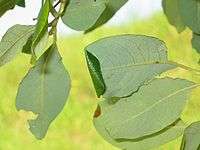Caloptilia stigmatella
| Caloptilia stigmatella | |
|---|---|
 | |
 | |
| Scientific classification | |
| Kingdom: | Animalia |
| Phylum: | Arthropoda |
| Class: | Insecta |
| Order: | Lepidoptera |
| Family: | Gracillariidae |
| Genus: | Caloptilia |
| Species: | C. stigmatella |
| Binomial name | |
| Caloptilia stigmatella (Fabricius, 1781)[1] | |
| Synonyms | |
| |
Caloptilia stigmatella is a moth of the Gracillariidae family. It is known from the Holarctic Region, including all of Europe (except the Balkan Peninsula).

The wingspan is 12–14 millimetres (0.47–0.55 in). Adults are on wing in late June and July, and again from September onwards.[2]
The larvae feed on Myrica gale, Populus alba, Populus candicans, Populus canescens, Populus nigra, Populus tremula, Salix alba, Salix aurita, Salix babylonica, Salix cinerea, Salix dasyclados, Salix elaeagnos, Salix fragilis, Salix glaucosericea, Salix lanata, Salix magnifica, Salix myrsinifolia, Salix pentandra, Salix purpurea, Salix repens, Salix sitchensis, Salix spadicea, Salix x stipularis, Salix triandra, Salix udensis and Salix viminalis. They mine the leaves of their host plant. The mine starts with an unusually long lower-surface epidermal corridor that often follows the midrib for some distance, but finally turns towards the leaf margin, where a small blotch is made. The blotch is initially fully epidermal, but later the larva starts consuming parenchyma, silk is deposited and the blotch begins to develop into a somewhat contracted tentiform mine. Older larvae leave the mine and continue living freely under a leaf fold that has been bound together with silk, or in a leaf tip that has been turned into a cone. Pupation takes place in a shiny cocoon at the underside of the leaf.[3]
References
- ↑ "Caloptilia stigmatella (Fabricius, 1781)". 2.5. Fauna Europaea. July 23, 2012. Retrieved March 24, 2013.
- ↑ UKmoths
- ↑ bladmineerders.nl